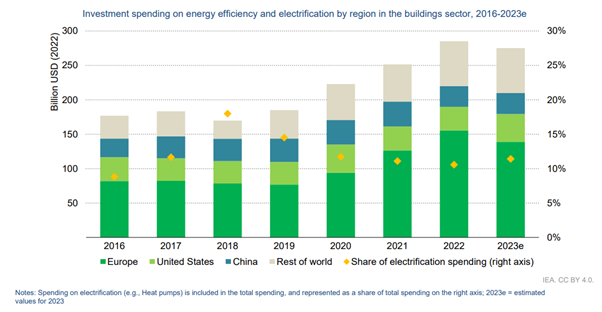Our industry is engaged in an important dialogue to improve sustainability through ESG transparency and industry collaboration. This article is a contribution to this larger conversation and does not necessarily reflect GRESB’s position.
The built environment shoulders a significant emissions burden, contributing 38 percent of the total global carbon emissions, according to the International Energy Agency (IEA). Yet, the built environment is also an area containing sectors with great potential for emissions reductions — sectors that may pioneer the transition towards a greenhouse gas (GHG) emission-free planet. Particularly, buildings, with their complex mechanical and electrical systems, could become the primary battleground for increased efficiency and renewable integration.
In the months following the COP28 conference, we await a comprehensive evaluation that discloses the current path of emissions reductions, presenting opportunities for cost reduction, heightened efficiency, and improved performance. Owners find themselves at a crossroads: on one hand, they are compelled by evolving legislation and codes that push for sustainability. Simultaneously, business imperatives underscore the potential for profitability through operational cost reduction.
The IEA predicts a slowdown in global investment in energy efficiency, electrification, and renewable energy in 2023 after reaching record investment levels in 2022. Despite a 16 percent increase in investment in 2022, the IEA projects growth of just four percent in 2023, posing a threat to net-zero emissions goals. The 2022 global energy crisis boosted investment, but uncertainties in the economic future, government programs, and credit availability all contribute to a projected five percent drop in energy efficiency spending in the construction industry. To meet 2030 emissions targets, the IEA emphasizes the need to triple the global investment in energy efficiency.

Energy efficiency spending on buildings rose in 2022, but the ongoing cost-of-living crisis and enduring economic uncertainty could reduce investment in 2023, according to the IEA.
Global challenges and collective commitment
Decarbonization must be a global effort. Although 80 percent of primary energy still comes from fossil sources, according to the United Nations (UN), energy transition efforts should focus on scaling up new technologies such as carbon capture, hydrogen fuel, large-scale renewables, and energy storage. Despite record emissions in 2022, it is crucial to aim for the 1.5°C target established in the Paris Agreement in 2015. To reach such a goal, we must consider technological and financial risks in addition to customer involvement.
Digitalization and building rehabilitation are crucial levers in the built environment. Solid business plans are needed to improve operating costs and financing. With the support of available technology, decarbonization is feasible, but requires a comprehensive approach. Companies and organizations across Europe are at the forefront of these changes, creating value and seeking financial and technological solutions for a sustainable future.
Decarbonization in buildings: A multifaceted challenge
Decarbonization efforts often hinge on a building’s source of fuel. Fossil fuels contribute significantly to carbon emissions. As such, it is paramount to address boiler and chiller systems, offering a dual focus on demand-side reduction and a swift transition to clean energy on the supply side.
Key considerations for building owners and managers
- Decarbonization roadmaps prioritize impactful, cost-effective measures
- Transitioning to clean energy necessitates short payback periods, especially for existing buildings
- The financial sector is key. NextGenerationEU and the Energy Savings Certificate mechanism (CEE) in Europe, and the Inflation Reduction Act (IRA) in the U.S. play a crucial role in incentivizing energy efficiency
Overcoming barriers: A three-pronged approach
1. Where to start: Prioritizing opportunities
Navigating the complexity of decarbonization requires a systematic approach. Prioritizing and rating opportunities is crucial, offering a roadmap that begins with impactful and straightforward measures before progressing to more intricate and costly solutions.
2. Short-term gains and convincing customers
Transparent communication is key to convincing stakeholders and emphasizing short-term gains can win initial support. Bringing energy discussions to the boardroom of an organization fosters a culture of transparency and commitment.
3. Funding and legislation challenges
Financial backing and legislative support have emerged as substantial barriers. Collaborative efforts between public and private sectors, exemplified by policies such as the European Union’s (EU) “Fit for 55” package, illustrate a pathway to overcome these challenges and accelerate decarbonization.
The opportunities and challenges mentioned above are key obstacles for real estate companies to address in the built environment. According to the GRESB Real Estate Benchmark, 58 percent of European companies and funds have net-zero targets, and an impressive 77 percent have net-zero policies. With insightful data and actors such as GRESB making a tremendous effort to discern data insights from the real estate sector, there is a clear need to move from policies and targets to implementing concrete strategies that will enable the transition to a GHG emissions-free future. Thus, a critical time for decarbonization requires a concerted effort by stakeholders to seize opportunities, overcome challenges, and collectively steer toward a sustainable, low-carbon future.
This article was written by Sergio Quintero, Sustainability Manager, at Mace Group Spain.
References
Broc, Jean-Sebastien. “Make Energy Efficiency Visible in the Energy Mix.” BUILD UP, European Commission. Institute for European Energy and Climate Policy, November 2023.
Gould, Tim, and Jonathan Coppel. “World Energy Investment 2023.” Global Energy Transitions Stocktake. International Energy Agency, May 2023.
United Nations Environment Programme. “Emissions Gap Report 2023: Broken Record – Temperatures hit new highs, yet world fails to cut emissions (again). UNEP, November 2023.